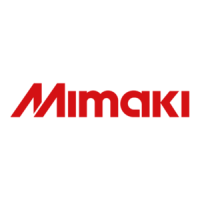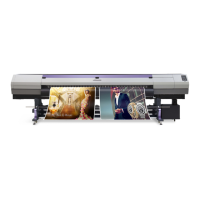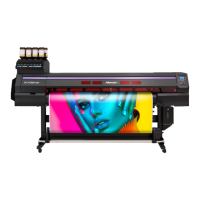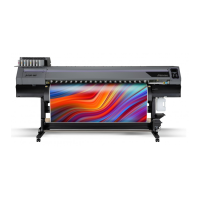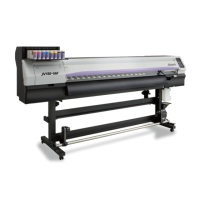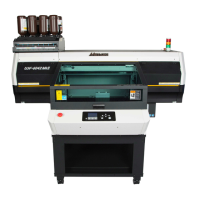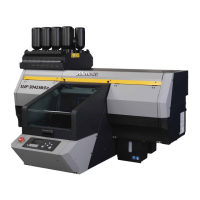Do you have a question about the MIMAKI SWJ-320EA and is the answer not in the manual?
Explains the meaning of safety icons used in the manual.
Key safety warnings for operation, environment, and power.
Guidelines for the proper disposal of the machine.
Detailed safety measures for operation, handling, and environment.
Important warnings and advice for handling materials and maintenance.
Important considerations for safely installing the machine.
Explanation of safety features that stop operation when covers are opened.
Identifies and explains the meaning of warning labels on the machine.
Guidance on selecting a location and preparing the machine for installation.
Description of parts on the front of the machine, including operation panel.
Description of parts on the rear and right side of the machine.
Explanation of the printer's control panel, display, and buttons.
Details on the heater system, media sensor, and carriage mechanisms.
Explanation of the capping station, wiper, ink caps, pinch rollers, and feed rollers.
Instructions for connecting the printer via LAN and USB.
Steps for connecting the power supply and filling ink tanks.
Information on IC chips, ink status indicators, and ink expiration.
Details on usable media sizes and types.
Important advice on handling media to prevent printing issues.
Outlines the sequence of basic operations for using the machine.
Step-by-step guide to safely turn the printer on and off.
Instructions for setting media, including head height adjustment.
Detailed steps for loading standard roll media.
Specific instructions for setting up narrow roll media.
Specific instructions for setting up two narrow roll media simultaneously.
Procedures for loading leaf media and removing taken-up media.
Performing test prints and adjusting heater temperatures for optimal printing.
Steps for performing different types of head cleaning based on test print results.
Adjusting media feed rate and ink drop position for accurate printing.
Managing print jobs, including starting, stopping, and clearing data.
Customizing print conditions and optimizing settings for different media.
Configuring power, feeding, take-up, display, and network settings.
Setting up network connections and email notifications for machine events.
Managing security settings, resetting configurations, and accessing machine information.
Safety guidelines and cleaning fluid information before performing maintenance.
Procedures for cleaning the platen, heater cover, media sensor, and media press.
Introduction to the maintenance menu and its functions.
Maintaining the capping station, wiper, and ink discharge passage for optimal performance.
Instructions for custody wash to prepare the machine for extended periods of non-use.
Cleaning the ink head and its immediate surroundings carefully.
Steps for washing head nozzles and performing nozzle recovery.
Setting intervals for automatic refresh and head cleaning functions.
Procedures for discarding waste ink and managing its levels.
Steps for replacing wipers and the mist fan filter.
Steps for replacing ink tanks and cap absorbers.
Introduction to identifying and resolving machine issues.
Solutions for the machine not turning on or failing to start printing.
Troubleshooting media jams, poor image quality, and nozzle clogging.
Addressing ink tank warnings, leaks, sub-tank errors, and ink mixture problems.
Detailed explanations and solutions for all displayed warning and error codes.
Detailed technical specifications of the printer hardware and capabilities.
Information on ink types, capacity, storage, and shelf life.
List of parts and their corresponding part codes for ordering.
Guidance on the correct order for installing ink tanks.
A form for reporting troubles and providing necessary machine information.
Explains the meaning of safety icons used in the manual.
Key safety warnings for operation, environment, and power.
Guidelines for the proper disposal of the machine.
Detailed safety measures for operation, handling, and environment.
Important warnings and advice for handling materials and maintenance.
Important considerations for safely installing the machine.
Explanation of safety features that stop operation when covers are opened.
Identifies and explains the meaning of warning labels on the machine.
Guidance on selecting a location and preparing the machine for installation.
Description of parts on the front of the machine, including operation panel.
Description of parts on the rear and right side of the machine.
Explanation of the printer's control panel, display, and buttons.
Details on the heater system, media sensor, and carriage mechanisms.
Explanation of the capping station, wiper, ink caps, pinch rollers, and feed rollers.
Instructions for connecting the printer via LAN and USB.
Steps for connecting the power supply and filling ink tanks.
Information on IC chips, ink status indicators, and ink expiration.
Details on usable media sizes and types.
Important advice on handling media to prevent printing issues.
Outlines the sequence of basic operations for using the machine.
Step-by-step guide to safely turn the printer on and off.
Instructions for setting media, including head height adjustment.
Detailed steps for loading standard roll media.
Specific instructions for setting up narrow roll media.
Specific instructions for setting up two narrow roll media simultaneously.
Procedures for loading leaf media and removing taken-up media.
Performing test prints and adjusting heater temperatures for optimal printing.
Steps for performing different types of head cleaning based on test print results.
Adjusting media feed rate and ink drop position for accurate printing.
Managing print jobs, including starting, stopping, and clearing data.
Customizing print conditions and optimizing settings for different media.
Configuring power, feeding, take-up, display, and network settings.
Setting up network connections and email notifications for machine events.
Managing security settings, resetting configurations, and accessing machine information.
Safety guidelines and cleaning fluid information before performing maintenance.
Procedures for cleaning the platen, heater cover, media sensor, and media press.
Introduction to the maintenance menu and its functions.
Maintaining the capping station, wiper, and ink discharge passage for optimal performance.
Instructions for custody wash to prepare the machine for extended periods of non-use.
Cleaning the ink head and its immediate surroundings carefully.
Steps for washing head nozzles and performing nozzle recovery.
Setting intervals for automatic refresh and head cleaning functions.
Procedures for discarding waste ink and managing its levels.
Steps for replacing wipers and the mist fan filter.
Steps for replacing ink tanks and cap absorbers.
Introduction to identifying and resolving machine issues.
Solutions for the machine not turning on or failing to start printing.
Troubleshooting media jams, poor image quality, and nozzle clogging.
Addressing ink tank warnings, leaks, sub-tank errors, and ink mixture problems.
Detailed explanations and solutions for all displayed warning and error codes.
Detailed technical specifications of the printer hardware and capabilities.
Information on ink types, capacity, storage, and shelf life.
List of parts and their corresponding part codes for ordering.
Guidance on the correct order for installing ink tanks.
A form for reporting troubles and providing necessary machine information.
| Print Technology | Inkjet |
|---|---|
| Print Resolution | 1200 x 1200 dpi |
| Connectivity | USB, Ethernet |
| Power Supply | AC 100-240V, 50/60Hz |
| Printing Method | Piezoelectric |
| Maximum Print Width | 3200 mm |
| Ink Type | Solvent ink |
| Ink Colors | C, M, Y, K |
| Media Types | Vinyl, Paper, Banner |
| Media Width | Up to 3.2 m |
| Media Thickness | 1 mm |

